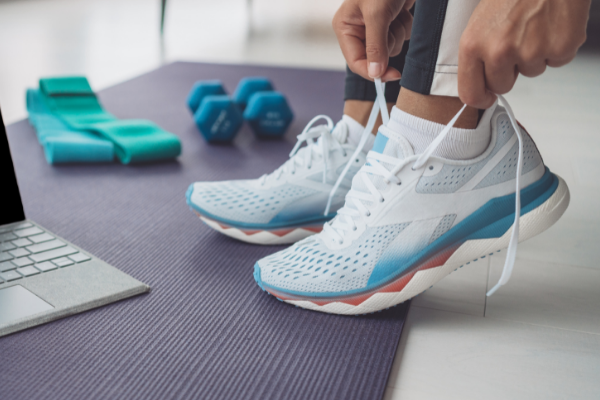
Maintaining a regular fitness routine is so important, especially as you get older. Perimenopause (the period before menopause) typically begins in your forties, but can start as early as your thirties for some people. You may experience symptoms like hot flashes, changes in your mood, irregular periods and fluctuations in your weight. With all these changes happening in your body, it’s essential to maintain your health and fitness. Take a look at our perimenopause fitness tips for weight loss and management.
What is Perimenopause?
Perimenopause is the transitional period before menopause. Your levels of estrogen start to decrease and you may start experiencing menopause-like symptoms such as hot flashes or missed/irregular periods. During this time, your body is moving towards your final reproductive years. During perimenopause, your fertility is on the decline, but you can still become pregnant.
When Does Perimenopause Start?
Perimenopause typically starts in ages 40 to 44 but can begin for some people as early as their mid-30s and as late as their mid-50s. You’ll usually notice changes in menstrual flow and in the length of your cycle. Although some people experience perimenopause for only a short period of time, for most it can last for years. You’ll know perimenopause has ended and menopause has begun when you go 12 months without a period.
10 Perimenopause Symptoms
1. Irregular periods or skipping periods
2. Periods that are heavier or lighter than usual
3. Hot flashes and night sweats
4. Vaginal dryness and discomfort during sex
5. Urinary urgency
6. Sleep problems
7. Mood changes like irritability, depression or mood swings
8. Fatigue
9. Problems with memory and concentration
10. Weight gain
Why Do Women Gain Weight During Perimenopause?
During perimenopause, your estrogen levels start to fluctuate and your body starts looking for an estrogen replacement and finds one in fat. Fat produces estrone, the weakest version of estrogen, so the body deposits fat very readily, especially in the midsection. Fluctuations in hormones can also lead to increased appetite.
Weight gain during this time can also be attributed to aging and lifestyle factors. Muscle mass typically diminishes with age while fat increases. Losing muscle mass slows your metabolism, which can make it more challenging to maintain a healthy weight. Lack of exercise, unhealthy eating and poor sleep can also contribute to weight gain.
9 Perimenopause Fitness Tips
1. Do Aerobic Exercise on The Regular
Aerobic exercise (also known as endurance activities) such as brisk walking, jogging, biking or swimming can help you shed excess pounds and maintain a healthy weight. Try to do 30 minutes of aerobic exercise five days per week. Losing estrogen can increase your risk of developing heart disease and type 2 diabetes and aerobic exercise is one of the best ways to reduce this risk.
2. Strengthen Your Joints
Incorporate exercise where the body takes impact through the joints such as hiking, dancing, boxing, skipping, running and sports like tennis. This type of exercise keeps your bones strong and helps protect against osteoporosis.
3. Incorporate Strength Training
Strength training is so important, especially as you get older. Regular strength training can help you reduce body fat, strengthen your muscles and burn calories more efficiently. After ages 40 to 50 and as your estrogen levels drop, your risk for breaking bones also increases. Strength training builds muscle, which helps prevent falls and therefore breaking a bone. It also helps maintain better posture, stability and flexibility.
4. Try Interval Training
Interval training incorporates training at a healthy rate, then increasing intensity for a short sprint, then repeating. You could do this on a bike, rowing machine, treadmill or jogging outside. Cardio can help reduce weight, maintain a healthy weight and manage stress levels, which can also increase during perimenopause.
5. Don’t Underestimate The Power of Walking
Walking is amazing exercise and may be the perfect fit for you during perimenopause. You may feel like you need to do intense cardio to lose weight, but this can add stress to the body when it’s already going through a lot. Brisk walking can help you maintain a healthy weight, improve your cardio and boost your mood and energy levels. If you want a challenge, consider wearing ankle or wrist weights while walking.
6. Work on Stability and Balance
Balance exercises improve stability and can help prevent falls. Activities like tai chi and yoga are helpful for stability and balance, as are simple exercises such as standing on one leg while brushing your teeth. Balance exercises also reduce the risk of lower extremity injuries such as knee and ankle injuries.
7. Stretching is Key
It’s so important to maintain your flexibility as you get older. It decreases the risk of injury and also improves your ability to perform regular daily activities. Stretching is a great way to improve flexibility. Try to stretch after each workout you do and make time to stretch on days you don’t workout as well.
8. Mix It Up
During perimenopause it’s important to exercise regularly and mix things up to keep improving your health. Rotate between brisk walking, strength training, interval training, aerobic exercise, biking, jogging, yoga, tennis and any other exercise you love to do. By switching things up throughout the week you give overused muscles and joints a chance to recover, beat workout boredom and can steer clear of a weight loss plateau.
9. Workout With Friends
If you’re feeling a lack of motivation to exercise, get a group of friends together and form a workout crew. Start a group texting chat where you share the fitness classes you’re going to, hikes or walks you’re planning or set up times for a tennis game meet up. You don’t have to commit to everything, but having a workout group is sure to boost your motivation.
If you’ve started to experience perimenopause symptoms and are looking for ways to stay healthy, we hope you find these perimenopause fitness tips helpful!



